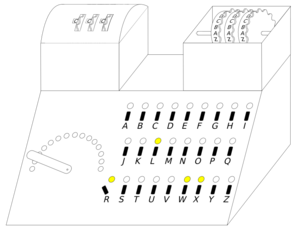- Cyclometer
-
"Cyclometer" also means a person who works either on the classic circle-squaring problem or on the geometry of circles. For the device used in cycling, see cyclocomputer.
 Cyclometer, devised in the mid-1930s by Rejewski to catalog the cycle structure of Enigma permutations. 1: Rotor lid closed, 2: Rotor lid open, 3: Rheostat, 4: Glowlamps, 5: Switches, 6: Letters.
Cyclometer, devised in the mid-1930s by Rejewski to catalog the cycle structure of Enigma permutations. 1: Rotor lid closed, 2: Rotor lid open, 3: Rheostat, 4: Glowlamps, 5: Switches, 6: Letters.
The cyclometer was a cryptologic device designed, "probably in 1934 or 1935," by Marian Rejewski of the Polish Cipher Bureau's German section (BS-4) to facilitate decryption of German Enigma ciphertext.[1]
Contents
History
The cyclometer was used to prepare a catalog of the length and number of cycles in the "characteristics" for all 17,576 positions of the rotors for a given sequence of rotors. Since there were six such possible sequences, the resulting "catalog of characteristics," or "card catalog," comprised a total of (6) (17,576) = 105,456 entries.[2]
The utility of the card catalog, writes Rejewski, was independent of the number of plug connections being used by the Germans on their Enigma machines (and of the reconstruction of message keys). Preparation of the catalog "was laborious and took over a year, but when it was ready... daily keys [could be obtained] within about fifteen minutes."[3]
On November 1, 1937, however, the Germans changed the "reversing drum," or "reflector." This forced the Cipher Bureau to start over again and produce a new card catalog, "a task," writes Rejewski, "which consumed, on account of our greater experience, probably somewhat less than a year's time."[4]
But then, on September 15, 1938, the Germans changed entirely the procedure for enciphering message keys, and as a result the card-catalog method became completely useless.[4] This spurred the invention of Rejewski's cryptologic bomb and Zygalski's perforated sheets.[5]
See also
Biuro Szyfrów Methods and technology "ANX" · Enigma "doubles" · Grill
Clock · Cyclometer · Card catalog
Cryptologic bomb
Zygalski sheets · LacidaLocations Saxon Palace · Kabaty Woods
PC Bruno · CadixPersonnel Chief
Gwido LangerGerman Section cryptologists
Marian Rejewski · Jerzy Różycki
Henryk Zygalski · Antoni Palluth
Wiktor MichałowskiChief of Russian Section
Jan GralińskiRussian Section cryptologist
Piotr SmoleńskiThe Enigma
cipher machine
- Cryptologic bomb: a machine designed about October 1938 by Marian Rejewski to facilitate the retrieval of Enigma keys.
- Bombe: a machine, inspired by Rejewski's "(cryptologic) bomb," that was used by British and American cryptologists during World War II.
- Cryptanalysis of the Enigma and Enigma machine.
- Zygalski sheets: invented about October 1938 by Henryk Zygalski and called "perforated sheets" by the Poles, they made possible the recovery of the Enigma's entire cipher key.
Notes
- ^ Marian Rejewski, "Summary of Our Methods for Reconstructing ENIGMA and Reconstructing Daily Keys...", p. 242.
- ^ Marian Rejewski, "The Mathematical Solution of the Enigma Cipher," pp. 284–87.
- ^ Marian Rejewski, "Summary of Our Methods...", p. 242.
- ^ a b Rejewski, "Summary of Our Methods...", p. 242.
- ^ Rejewski, "Summary of Our Methods...", pp. 242–43.
References
- Władysław Kozaczuk, Enigma: How the German Machine Cipher Was Broken, and How It Was Read by the Allies in World War Two, edited and translated by Christopher Kasparek, Frederick, MD, University Publications of America, 1984, ISBN 0-89093-547-5.
- Marian Rejewski, "Summary of Our Methods for Reconstructing ENIGMA and Reconstructing Daily Keys, and of German Efforts to Frustrate Those Methods," Appendix C to Władysław Kozaczuk, Enigma: How the German Machine Cipher Was Broken, and How It Was Read by the Allies in World War Two, 1984, pp. 241–45.
- Marian Rejewski, "The Mathematical Solution of the Enigma Cipher," Appendix E to Władysław Kozaczuk, Enigma: How the German Machine Cipher Was Broken, and How It Was Read by the Allies in World War Two, 1984, pp. 272–91.
External links
Categories:- Science and technology in Poland
- Biuro Szyfrów
Wikimedia Foundation. 2010.
